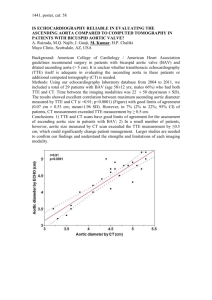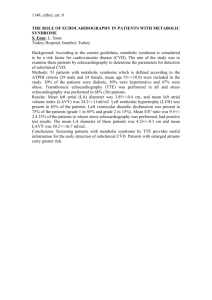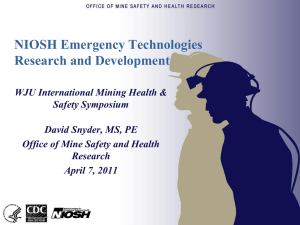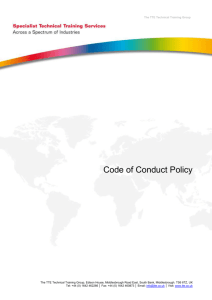Cardiac ultrasound fellowship
advertisement
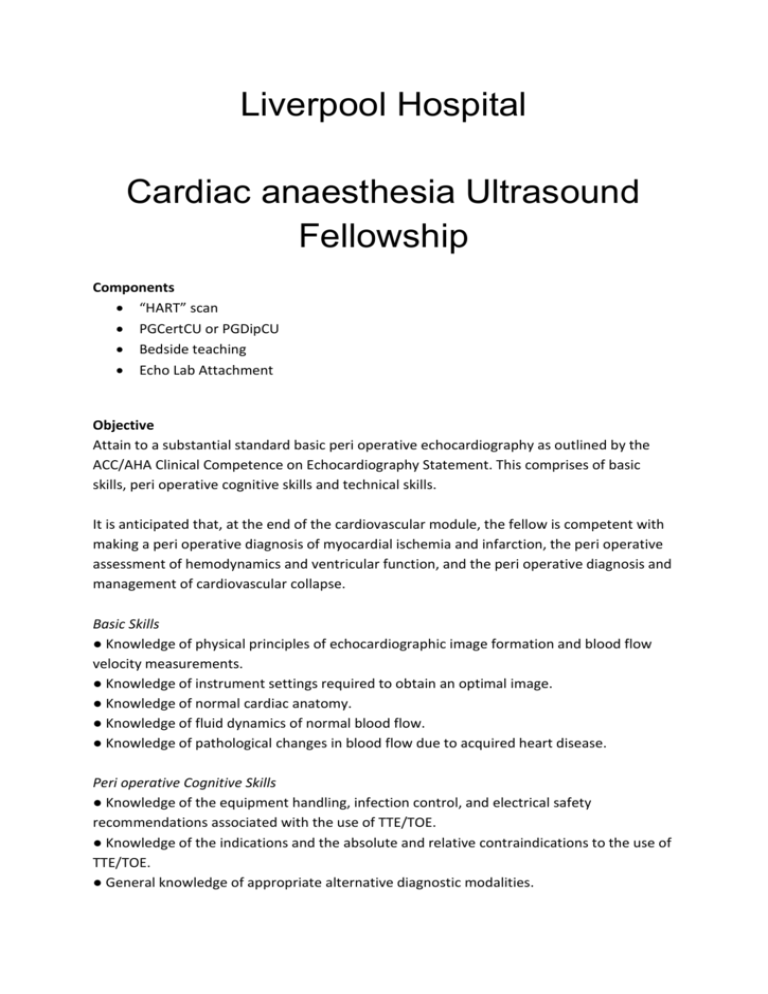
Liverpool Hospital Cardiac anaesthesia Ultrasound Fellowship Components “HART” scan PGCertCU or PGDipCU Bedside teaching Echo Lab Attachment Objective Attain to a substantial standard basic peri operative echocardiography as outlined by the ACC/AHA Clinical Competence on Echocardiography Statement. This comprises of basic skills, peri operative cognitive skills and technical skills. It is anticipated that, at the end of the cardiovascular module, the fellow is competent with making a peri operative diagnosis of myocardial ischemia and infarction, the peri operative assessment of hemodynamics and ventricular function, and the peri operative diagnosis and management of cardiovascular collapse. Basic Skills ● Knowledge of physical principles of echocardiographic image formation and blood flow velocity measurements. ● Knowledge of instrument settings required to obtain an optimal image. ● Knowledge of normal cardiac anatomy. ● Knowledge of fluid dynamics of normal blood flow. ● Knowledge of pathological changes in blood flow due to acquired heart disease. Peri operative Cognitive Skills ● Knowledge of the equipment handling, infection control, and electrical safety recommendations associated with the use of TTE/TOE. ● Knowledge of the indications and the absolute and relative contraindications to the use of TTE/TOE. ● General knowledge of appropriate alternative diagnostic modalities. ● Knowledge of the normal cardiovascular anatomy as visualized by TTE/TOE. ● Knowledge of commonly encountered blood flow velocity profiles as measured by Doppler echocardiography. ● Detailed knowledge of the echocardiographic presentations of myocardial ischemia and infarction. ● Detailed knowledge of the echocardiographic presentations of normal and abnormal ventricular function. ● Detailed knowledge of the physiology and TTE/TOE presentation of air embolization. ● Knowledge of native valvular anatomy and function, as displayed by TTE/TOE. ● Knowledge of the major TTE/TOE manifestations of valve lesions and of the TTE/TOE techniques available for assessing lesion severity. ● Knowledge of the principal TTE/TOE manifestations of cardiac masses, thrombi, and emboli; cardiomyopathies; pericardial effusions and lesions of the great vessels. Peri operative Technical Skills ● Ability to operate the ultrasound machine, including controls affecting the quality of the displayed data. ● Ability to perform a basic cardiac echo examination. ● Ability to recognize major echocardiographic changes associated with myocardial ischemia and infarction. ● Ability to detect qualitative changes in ventricular function and hemodynamic status. ● Ability to recognize echocardiographic manifestations of air embolization. ● Ability to visualize cardiac valves in multiple views and recognize gross valvular lesions and dysfunction. ● Ability to recognize large intracardiac masses and thrombi. ● Ability to detect large pericardial effusions. ● Ability to recognize common artifacts and pitfalls in TEE examinations. ● Ability to communicate the results of a TTE/TOE examination to patients and other health care professionals and to summarize these results cogently in the medical record. Syllabus Physical principles of US: Sound source, Frequency, Wavelength and tissue propagation velocity Amplitude, Power and Intensity, Beam characteristics: The Duty factor, The Spatial Pulse Length, Pulse repetition frequency, Pulse repetition period, Frame Rate Attenuation, Absorption, Reflection, Refraction, Scattering, Resolution Transducer types and selection Principles of Doppler US US modes: A mode, B mode, M mode, 2D, Doppler, colour Doppler, Colour M mode, tissue Doppler, 3D Image processing: Gain, compression, TGC, digital processing Knobology Anatomy and physiology of the heart Measurements and calculations Cardiac dimensions, pressure gradients, FS, FAC, EF, SV, CO, PISA, ERO, PHT, shunt fraction Indications, contraindications, limitations, and safety of TTE and TOE Comparison of cardiac US and other imaging modalities. Image planes and standard views of TTE and TOE Use of cardiac US to evaluate: Artefacts, pitfalls and masses Anatomy and Systolic LV function: Global and RWMA, complications of IHD, cardiomyopathies Diastolic LV function Anatomy and RV function Valvular function: MV anatomy, MR and MS AV anatomy, AR and AS TV and PV anatomy and function Prosthetic valves recognition and dysfunction Pericardial disease: Effusion, tamponade, constrictive pericarditis Aorta: Anatomy, atheroma, dissection Haemodynamic status assessment: Hypovolaemia, sepsis, heart failure Pulmonary disease: Pleural effusion Adult congenital heart disease Requirements Committed involvement of the participating registrar. Once a week attendance to the Echo Lab. Log Book of all the performed and reported cases. Xnumber of reported cases reviewed by and experience echocardiologist. Completion of 50 Studies and documentation with a logbook References Outline of Core Curriculum in Echocardiography American Society of Echocardiography ACC/AHA Clinical Competence Statement on Echocardiography 2003

